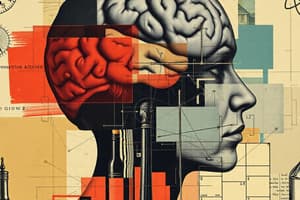Podcast
Questions and Answers
Science mitigates cognitive predispositions through methodical observation, ______, and iterative duplication.
Science mitigates cognitive predispositions through methodical observation, ______, and iterative duplication.
falsifiability
Contrary to mere conjecture, science prioritizes ______ substantiation as the bedrock for validating assertions.
Contrary to mere conjecture, science prioritizes ______ substantiation as the bedrock for validating assertions.
empirical
The predilection to selectively seek data corroborating pre-existing convictions, while disregarding contradictory signals, is termed ______ bias.
The predilection to selectively seek data corroborating pre-existing convictions, while disregarding contradictory signals, is termed ______ bias.
confirmation
Karl Popper posited that a hallmark of scientific theories is their inherent ______, the capacity to be empirically refuted.
Karl Popper posited that a hallmark of scientific theories is their inherent ______, the capacity to be empirically refuted.
[Blank] bias manifests as the inclination to perceive past occurrences, even stochastic ones, as retrospectively predictable.
[Blank] bias manifests as the inclination to perceive past occurrences, even stochastic ones, as retrospectively predictable.
The cognitive anomaly wherein individuals underestimate their susceptibility to bias compared to their peers is known as the ______ spot.
The cognitive anomaly wherein individuals underestimate their susceptibility to bias compared to their peers is known as the ______ spot.
[Blank] neglect describes the cognitive tendency to discount foundational prevalence rates when assessing probabilistic judgments, often prioritizing specific anecdotal information.
[Blank] neglect describes the cognitive tendency to discount foundational prevalence rates when assessing probabilistic judgments, often prioritizing specific anecdotal information.
The 'halo' and 'horn' effects exemplify cognitive biases wherein a global impression of an individual in one domain disproportionately influences perceptions in unrelated domains, demonstrating a failure of independent assessment and potentially leading to spurious ______.
The 'halo' and 'horn' effects exemplify cognitive biases wherein a global impression of an individual in one domain disproportionately influences perceptions in unrelated domains, demonstrating a failure of independent assessment and potentially leading to spurious ______.
While generally unrelated to cognitive prowess, certain biases, such as the ______ spot, may paradoxically be amplified in individuals exhibiting higher cognitive abilities.
While generally unrelated to cognitive prowess, certain biases, such as the ______ spot, may paradoxically be amplified in individuals exhibiting higher cognitive abilities.
[Blank] skepticism advocates for intellectual receptiveness coupled with a rigorous demand for robust substantiating evidence.
[Blank] skepticism advocates for intellectual receptiveness coupled with a rigorous demand for robust substantiating evidence.
The principle of ______ Razor, also known as the law of parsimony, favors the most straightforward explanation among competing hypotheses.
The principle of ______ Razor, also known as the law of parsimony, favors the most straightforward explanation among competing hypotheses.
In stark contrast to psychological science, psychological ______ is characterized by a deficiency in falsifiability, self-correction, and replicability.
In stark contrast to psychological science, psychological ______ is characterized by a deficiency in falsifiability, self-correction, and replicability.
Psychological pseudoscience often substitutes systematic empirical data with ______, which are insufficient to establish generalizable claims.
Psychological pseudoscience often substitutes systematic empirical data with ______, which are insufficient to establish generalizable claims.
The phenomenon of ______ perseverance describes the tenacity of beliefs, even when confronted with contradictory empirical evidence.
The phenomenon of ______ perseverance describes the tenacity of beliefs, even when confronted with contradictory empirical evidence.
The counterintuitive phenomenon where individuals' beliefs are paradoxically strengthened when presented with disconfirming evidence is termed the ______ effect.
The counterintuitive phenomenon where individuals' beliefs are paradoxically strengthened when presented with disconfirming evidence is termed the ______ effect.
[Blank] costs in pseudoscience refer to the foregone benefits of engaging in more productive or efficacious endeavors.
[Blank] costs in pseudoscience refer to the foregone benefits of engaging in more productive or efficacious endeavors.
[Blank] harm, though not universally inherent to pseudoscience, can arise from certain pseudoscientific practices, underscoring the ethical implications.
[Blank] harm, though not universally inherent to pseudoscience, can arise from certain pseudoscientific practices, underscoring the ethical implications.
A diminished capacity for ______ thought is a significant detriment of pseudoscience, impairing essential civic and analytical competencies.
A diminished capacity for ______ thought is a significant detriment of pseudoscience, impairing essential civic and analytical competencies.
[Blank] is the human proclivity to discern patterns even in random or unstructured data, contributing to the allure of pseudoscientific explanations.
[Blank] is the human proclivity to discern patterns even in random or unstructured data, contributing to the allure of pseudoscientific explanations.
Pseudoscience often gains traction by providing simplistic elucidations for intricate issues, offering a sense of ______ in the face of complexity.
Pseudoscience often gains traction by providing simplistic elucidations for intricate issues, offering a sense of ______ in the face of complexity.
[Blank] skepticism mandates an evaluative stance towards claims, demanding robust empirical backing before according acceptance.
[Blank] skepticism mandates an evaluative stance towards claims, demanding robust empirical backing before according acceptance.
A cornerstone of scientific skepticism is ______-mindedness, characterized by an impartial evaluation of all claims, irrespective of prior disposition.
A cornerstone of scientific skepticism is ______-mindedness, characterized by an impartial evaluation of all claims, irrespective of prior disposition.
The principle of ______ in scientific thinking underscores that extraordinary claims necessitate commensurately compelling evidence.
The principle of ______ in scientific thinking underscores that extraordinary claims necessitate commensurately compelling evidence.
[Blank] testing involves formulating novel predictions from theories and subjecting them to empirical scrutiny to ascertain theoretical accuracy.
[Blank] testing involves formulating novel predictions from theories and subjecting them to empirical scrutiny to ascertain theoretical accuracy.
The principle of ______ in scientific inquiry pertains to the extent to which research findings can be extrapolated beyond the confines of the original study sample.
The principle of ______ in scientific inquiry pertains to the extent to which research findings can be extrapolated beyond the confines of the original study sample.
Flashcards
Confirmation Bias
Confirmation Bias
Tendency to seek evidence supporting beliefs and dismiss contradictory evidence.
Fixation
Fixation
Inability to see a problem from a new angle, hindering problem-solving.
Hindsight Bias
Hindsight Bias
The belief that random events were predictable after they have already occurred.
Bias Blind Spot
Bias Blind Spot
Signup and view all the flashcards
Base Rate Neglect
Base Rate Neglect
Signup and view all the flashcards
Halo and Horn Effects
Halo and Horn Effects
Signup and view all the flashcards
Falsifiability
Falsifiability
Signup and view all the flashcards
Occam's Razor
Occam's Razor
Signup and view all the flashcards
Pseudoscience
Pseudoscience
Signup and view all the flashcards
Scientific Theory
Scientific Theory
Signup and view all the flashcards
Belief Perseverance
Belief Perseverance
Signup and view all the flashcards
Backfire Effect
Backfire Effect
Signup and view all the flashcards
Patternicity
Patternicity
Signup and view all the flashcards
Scientific Skepticism
Scientific Skepticism
Signup and view all the flashcards
Extraordinary Claims
Extraordinary Claims
Signup and view all the flashcards
Testing Predictions
Testing Predictions
Signup and view all the flashcards
Generalizability
Generalizability
Signup and view all the flashcards
Replicability
Replicability
Signup and view all the flashcards
Ruling out rival hypotheses
Ruling out rival hypotheses
Signup and view all the flashcards
Empiricism
Empiricism
Signup and view all the flashcards
Theory
Theory
Signup and view all the flashcards
Hypothesis
Hypothesis
Signup and view all the flashcards
Falsifiability
Falsifiability
Signup and view all the flashcards
Replication
Replication
Signup and view all the flashcards
Study Notes
How Science Safeguards Against Fallacies
- Science uses systematic observation, falsifiability, and replication to counter cognitive biases.
- Science relies on empirical evidence rather than intuition.
- Claims are tested against objective data.
- A bias is a tendency to be disproportionately for or against an object, person, or idea, and can be good or bad.
Examples of Biases
- Confirmation bias involves seeking evidence that supports beliefs and dismissing evidence that contradicts them.
- Karl Popper stated that scientific theories must be falsifiable to address confirmation bias.
- Fixation is the inability to see a problem from a new perspective.
- Hindsight bias involves seeing events as more predictable after they occur, relating to anchoring bias.
- Bias blind spot is the tendency to believe one is less biased than peers.
- Base rate neglect is ignoring the underlying prevalence of a phenomenon when judging probabilities (focus on specific over general info).
- Halo and horn effects involve a positive/negative impression in one area affecting impression in other areas.
Bias and Cognitive Ability
- Most cognitive biases are typically unrelated to cognitive ability, while some (e.g., bias blind spot) may be stronger in those with high ability.
- Intelligence offers little protection from bias.
- Biases aren't inherently bad but can be problematic and often interfere with critical, scientific thinking.
- Because scientists are biased, science progresses through critique of each other's work.
Science as a Safeguard (Extra)
- Science uses empirical methods to counteract biases and fallacies.
- Confirmation bias countered by falsifiability.
- Scientific scepticism encourages open-mindedness while demanding strong evidence.
- Replication ensures generalizable findings.
- Occam's Razor prefers simpler explanations.
Levels of Analysis (Depression)
- Social level: Loss of relationships, lack of support.
- Behavioral level: Decreased pleasure.
- Mental level: Depressed thoughts.
- Neurological/physiological level: Differences in brain function.
- Neurochemical level: Differences in brain messenger levels.
- Molecular level: Genetic variations predisposing to depression.
Psychological Pseudoscience vs. Science
- Psychological pseudoscience lacks falsifiability, self-correction, and replicability, relying on anecdotes and confirmation bias.
- Psychological science is grounded in empirical evidence, peer review, and the scientific method.
- Science is an approach to evidence and explanations.
- Pseudoscience is a set of claims that seems scientific, but is not.
- A scientific theory explains a large number of findings.
- A scientific theory ties multiple findings into one conceptual package.
- Requires a testable prediction known as a hypothesis.
Traits of Pseudoscience and Science
- Psychological science is based on empirical evidence, relies on falsifiable hypotheses, and is replicable and peer-reviewed.
- Psychological pseudoscience lacks safeguards against biases, uses anecdotes instead of systematic data, avoids self-correction, overuses ad hoc immunizing hypotheses, lacks replication and review.
- Belief perseverance: resistance to change when presented with contradicting evidence.
- Backfire effect happens when beliefs strengthen when faced with contradictory evidence.
Considerations with Pseudoscience
- Opportunity costs: Costs of not doing something more productive/effective.
- Direct harm: Some pseudoscience can cause direct harm.
- Inability to think critically: Misinformation can impair critical thinking.
Pseudoscience Summary
- Science involves theories and hypotheses to understand the world.
- Pseudoscience lacks safeguards, especially related to confirmation bias and belief perseverance.
- People seek meaning and comfort in beliefs, drawing them to pseudoscience.
- Pseudoscience is costly due to opportunity costs, direct harm, and impaired critical thinking.
Reasons for Attraction to Pseudoscience
- Humans seek patterns and meaning, making pseudoscience appealing due to simple explanations, emotional reassurance, and confirmation.
- Cognitive biases like belief perseverance and backfire effect reinforce pseudoscientific thinking.
- Patternicity: The human tendency to see patterns where none exist.
- Offers simple explanations for complex issues and provides comfort.
- Strong emotional attachment to existing beliefs may make it hard to change your mind.
- Contradictory evidence can strengthen pseudoscientific beliefs.
- Examples: Astrology, homeopathy, and conspiracy theories.
Scientific Scepticism
- Scientific scepticism involves evaluating claims with an open mind while requiring strong empirical evidence.
- It includes ruling out rival hypotheses, correlation vs. causation, and replicability.
Key Features of Scientific Scepticism
- Open-mindedness: Evaluating claims fairly with curiosity.
- Demanding strong evidence before accepting claims.
- Critical thinking is necessary.
Principles of Scientific Thinking
- Extraordinary Claims require persuasive evidence.
- Testing Predictions involves testing novel predictions by them and their rival scientists.
- Generalizability requires researchers to consider how well findings reflect a diversity of human experience.
- Replicability ensures the results can be duplicated in other studies.
- Ruling Out Rival Hypotheses means ensuring no important alternative explanations have been excluded.
- Correlation vs Causation: Ensuring A causes B (not just an association).
Basic Principles of Scientific Thinking
- Is based on empiricism, falsifiability, systematic testing, and replication.
- Science is a method, not a belief system: Grounded in empiricism which means knowledge through observation.
Theories and Hypotheses
- A theory is a broad explanation for a range of findings.
- Hypothesis: A specific, testable prediction derived from a theory.
Scientific Method
- Objective observation necessary.
- Falsifiability: the ability to disprove claims.
- Systematic testing through experiments.
- The replication crisis highlights the need for reform in psychology and scientific methodology.
Replication
- Foundational element of the scientific method.
- Shows that findings generalize.
- Media is more likely to report novel/sensational findings.
- Important to make sure that reliable info reaches the public.
Explanations for Poor Replication
- Publish-or-perish mentality exists.
- Publication bias can occur.
- P-hacking can contribute.
Conclusion
- Science counteracts biases by requiring empirical evidence and peer review.
- Pseudoscience exploits cognitive tendencies to create misleading claims.
- Scientific skepticism distinguishes truth from misinformation.
- The replication crisis demonstrates that even established scientific knowledge must be continuously tested.
- Cultural considerations: Science is viewed as a Western paradigm, but Indigenous Knowledge Systems offer valid perspectives.
Studying That Suits You
Use AI to generate personalized quizzes and flashcards to suit your learning preferences.




